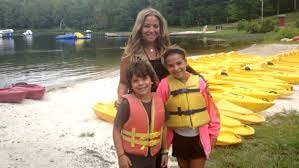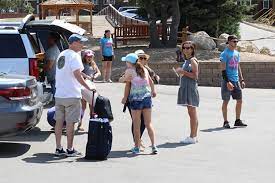Sleepaway camps have long been a popular choice for parents seeking a structured and immersive environment for their children during the summer months. These camps offer a wide range of activities and programs designed to foster personal growth, socialization, and independence.

This article aims to explore the history of sleepaway camps, the benefits they provide, as well as the typical daily schedule and available activities. Additionally, it will discuss important considerations when choosing the right camp for your child and provide tips for parents preparing to send their child away.
Key Takeaways of What Is Sleepaway Camp
- Sleepaway camps emerged in the late 19th century as a response to urbanization and provided children with a chance to experience nature and develop skills.
- Sleepaway camps have evolved over time to incorporate structured activities that focus on personal growth and skill development.
- Sleepaway camps promote independence, self-reliance, social development, and personal growth through interaction with diverse peers and taking on new responsibilities.
- Sleepaway camps offer a well-structured and immersive environment with daily routines, traditions, and mealtime bonding opportunities, allowing children to learn new skills, make friends, and create lasting memories.
History of Sleepaway Camps
The history of sleepaway camps can be traced back to the late 19th century when they emerged as a response to urbanization and the need for children to experience nature and develop physical, social, and emotional skills.
Sleepaway camps have evolved significantly since their inception, adapting to societal changes and advancements in child development research. Originally focused on providing city-dwelling children with an escape from the industrialized cities, these camps began incorporating structured activities that promoted personal growth and skill development.

Over time, sleepaway camps have recognized their impact on child development and have adapted their programs accordingly. Today, sleepaway camps provide a range of opportunities for children to learn new skills, build resilience, foster independence, form lasting friendships, and gain a sense of belonging.
These benefits contribute to the positive growth and development of campers during their time away from home.
Benefits of Sleepaway Camps
One potential advantage of attending overnight programs is the opportunity for young individuals to develop independence and self-reliance. Sleepaway camps provide a unique environment where children can gain valuable life skills and experiences that are not typically available in their everyday routines.
Some benefits of attending sleepaway camps include:
- Social development: Camps offer opportunities for children to interact with peers from diverse backgrounds, fostering social skills such as teamwork, communication, and conflict resolution.
- Personal growth: Being away from home allows campers to take on new responsibilities, make decisions independently, and build self-confidence.
- Outdoor experiences: Many sleepaway camps offer activities like hiking, swimming, and adventure sports that expose children to nature and promote physical fitness.
These benefits contribute to the holistic development of young individuals by providing them with a supportive environment to learn and grow through new experiences.
Typical Daily Schedule at Sleepaway Camp
A typical daily schedule at a sleepaway camp includes various structured activities and routines that aim to provide a well-rounded experience for young individuals. These daily routines are designed to promote physical, emotional, and social development while also fostering a sense of community and belonging.
Camp traditions play an important role in shaping the overall camp experience, allowing campers to engage in shared experiences and create lasting memories.

One example of a daily routine at a sleepaway camp is the morning flag-raising ceremony, where campers gather together to raise the flag while reciting the Pledge of Allegiance or singing an anthem. This ritual not only instills a sense of patriotism but also strengthens feelings of unity among campers.
Another key aspect of the daily schedule is mealtime, which serves as an opportunity for campers to come together as a community and bond over shared meals. In many sleepaway camps, meals are often accompanied by traditional songs or chants that add to the festive atmosphere.
Overall, these daily routines and camp traditions contribute to creating a well-structured and immersive environment where children can learn new skills, make friends, and develop lifelong memories.
Activities and Programs Offered at Sleepaway Camps
Activities and programs offered at sleepaway camps provide campers with a diverse range of opportunities for personal growth, skill development, and recreational engagement. These activities are carefully designed to cater to the interests and abilities of campers while promoting teamwork, independence, and self-confidence.
Some of the common activities found at sleepaway camps include:
- Outdoor Adventures:
- Hiking and nature walks
- Canoeing or kayaking
- Archery or riflery
- Arts and Crafts:
- Painting or drawing
- Pottery or ceramics
- Jewelry making
- Sports and Recreation:
- Swimming or diving
- Soccer or basketball
- Climbing walls or ropes courses
These activities not only allow campers to explore new interests but also help foster important life skills such as problem-solving, communication, creativity, and physical fitness. Campers can choose from a variety of options that suit their preferences, ensuring an enriching experience during their time at sleepaway camp.
Choosing the Right Sleepaway Camp for Your Child
When considering the appropriate sleepaway camp for a child, it is crucial to evaluate the available options based on factors such as location, duration, cost, and program offerings. Choosing the right sleepaway camp can greatly impact a child’s experience and overall enjoyment of their time away from home. It is important to consider the distance from home as a factor in order to minimize travel time and potential homesickness. Additionally, the duration of the camp should align with both the child’s comfort level and family schedule. Cost is another important consideration as it varies widely among different camps. Finally, evaluating program offerings ensures that the camp aligns with the child’s interests and allows them to engage in activities they enjoy.
| Location | Duration | Cost ($) |
|---|---|---|
| Mountain Retreat Camp | 2 weeks | 1500 |
| Beachside Adventure Camp | 1 week | 1200 |
| Wilderness Exploration Camp | 4 weeks | 2500 |
| Arts and Crafts Camp | 3 weeks | 1800 |
Table: Examples of Different Sleepaway Camp Options
Dealing with homesickness is also an essential aspect when choosing a sleepaway camp. Parents should inquire about how staff members address homesickness as part of their programming. Some camps may have specific procedures in place to help children cope with feelings of homesickness while others may offer regular check-ins or counseling services. By considering these factors carefully, parents can make an informed decision when selecting a sleepaway camp that will provide their child with an enriching and enjoyable experience while minimizing any potential difficulties associated with being away from home.
What to Pack for Sleepaway Camp
Packing appropriately for a child’s time away from home requires careful consideration of essential items and personal belongings that will ensure their comfort and enable them to fully engage in the camp’s activities.
Here are some tips for packing essentials for sleepaway camp:
- Clothing: Pack enough clothes for the duration of the camp, including underwear, socks, pajamas, and extra layers for varying weather conditions.
- Toiletries: Include toothbrush, toothpaste, shampoo, soap, sunscreen, insect repellent, and any necessary medication.
- Bedding: Most camps provide bedding but it’s always a good idea to bring a sleeping bag or sheets and blankets for added comfort.
Remember to label all items with your child’s name to avoid mix-ups. It is also important to check with the camp beforehand regarding any specific requirements or restrictions on what can be brought.
Health and Safety Measures at Sleepaway Camps
Health and safety guidelines are of utmost importance at sleepaway camps, especially in light of the ongoing COVID-19 pandemic. Camp organizers must implement precautionary measures to ensure the well-being of campers and staff. These measures include regular sanitization and disinfection of facilities, promoting frequent handwashing, enforcing physical distancing protocols, and conducting health screenings for all participants. In addition to these general precautions, sleepaway camps may also have specific guidelines in place to address COVID-19 concerns. The table below provides an overview of some common health and safety measures implemented at sleepaway camps:
| Health and Safety Measures | Description |
|---|---|
| Regular Sanitization | Camp facilities are regularly cleaned and disinfected to minimize the risk of transmission. |
| Hand Hygiene | Campers are encouraged to wash their hands frequently with soap and water or use hand sanitizer when necessary. |
| Physical Distancing | Measures such as rearranging sleeping arrangements or modifying activity schedules may be implemented to maintain physical distance between campers and staff. |
Tips for Parents When Sending Their Child to Sleepaway Camp
This section will discuss important considerations for parents when sending their child to sleepaway camp.
Specifically, it will focus on preparing for separation anxiety and choosing the right camp.

Preparing for separation anxiety involves providing reassurance to the child, maintaining open communication with camp staff, and gradually acclimating the child to being away from home.
When choosing the right camp, factors such as location, program offerings, safety measures, and reputation should be taken into account to ensure a positive and enriching experience for the child.
Preparing for Separation Anxiety
One aspect to consider when preparing for separation anxiety at sleepaway camp is implementing strategies to help children cope with being away from their primary caregivers.
It is important to provide them with tools and techniques that can alleviate their distress and promote a smooth transition into the camp experience.
Some helpful tips for parents include:
- Communicate: Encourage open dialogue about their concerns and fears regarding separation.
- Familiarize: Visit the camp beforehand or attend orientation sessions to familiarize your child with the environment.
- Establish routines: Create a consistent schedule during the days leading up to camp, similar to what they will experience at camp.
Choosing the Right Camp
When selecting a suitable program for their child, parents should consider various factors such as the camp’s activities, facilities, and staff qualifications.
Additionally, two important factors that parents should also take into account are the camp location and cost.
The camp location can greatly impact a child’s experience, as it determines the environment in which they will be spending their time. Parents should consider whether they prefer a camp located in a natural setting or one situated closer to urban areas.
Camp cost is another crucial aspect to consider, as it varies widely depending on factors such as duration, amenities offered, and reputation of the camp. Parents should carefully evaluate their budget and determine what they are willing to spend on their child’s summer experience before making a final decision.
Frequently Asked Questions
What Are the Costs Associated With Sending a Child to Sleepaway Camp?
Sleepaway camp costs can vary depending on factors such as location, duration, amenities, and program offerings. Additional expenses may include transportation, equipment, and optional activities. It is important to consider these factors when budgeting for sending a child to sleepaway camp.
How Can Parents Stay in Contact With Their Child While They Are at Sleepaway Camp?
Staying connected with a child at sleepaway camp is crucial for managing homesickness. Parents can communicate through various means, such as letters, phone calls, or even email. These methods help ease both the child’s and parents’ anxieties during their time apart.
Are There Any Age Restrictions for Attending Sleepaway Camps?
Age restrictions for sleepaway camps vary depending on the camp’s policies. Some camps may have minimum age requirements, typically around 7 or 8 years old, while others may offer programs for older children and teenagers. It is important to check with individual camps for their specific age restrictions.
Can Children With Allergies or Specific Dietary Needs Be Accommodated at Sleepaway Camps?
Accommodation options at sleepaway camps may vary in their ability to cater to children with allergies or specific dietary needs. Some camps provide specialized menus and can make accommodations, while others may have limited options.
Is There a Minimum or Maximum Duration for Sleepaway Camp Sessions?
The minimum and maximum duration for sleepaway camp sessions vary depending on the specific camp. Some camps offer short sessions of a few days, while others provide longer sessions lasting several weeks.
Conclusion
Sleepaway camps have a rich history, offering numerous benefits to children. These camps provide a structured daily schedule filled with various activities and programs aimed at promoting personal growth and development. Selecting the right sleepaway camp for your child requires careful consideration of their interests and needs. When packing for sleepaway camp, it is essential to include necessary items while keeping in mind any health and safety measures implemented by the camp. Parents can ensure a positive experience for their child by following helpful tips when sending them off to sleepaway camp.
Conclusion:
Sleepaway camps are an invaluable experience that every child should have the opportunity to enjoy. With their long-established history, these camps offer countless benefits, fostering personal growth and development in children. From a well-structured daily schedule to engaging activities and programs, sleepaway camps provide an environment where children can thrive. By carefully selecting the right camp, packing appropriately, and considering health and safety measures, parents can ensure their child has a memorable and safe experience at sleepaway camp.




